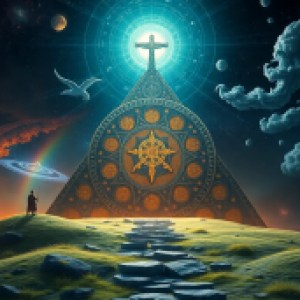Celtic Astrology: How the Stars Influenced Ancient Lives
I. Introduction
Celtic astrology refers to the astrological beliefs and practices of the ancient Celtic peoples, who inhabited regions such as Ireland, Scotland, Wales, and Brittany. It is characterized by a deep connection to nature, the cycles of the moon, and the rhythms of the earth.
The significance of Celtic astrology in ancient Celtic culture cannot be overstated. It played a crucial role in various aspects of life, from agriculture to spirituality. The Celts viewed the cosmos as a living entity, where celestial bodies were not just astronomical phenomena but were imbued with meaning and influence over everyday life.
This article aims to explore the rich tapestry of Celtic astrology, examining its celestial framework, the Druid zodiac, its impact on daily life, and its lasting legacy in modern spirituality.
II. The Celestial Framework: Understanding the Cosmos
The night sky held immense importance in Celtic society, serving as a source of guidance and inspiration. The Celts were keen observers of the heavens, and their understanding of celestial movements was integral to their worldview.
Key celestial bodies in Celtic astrology included:
- The Sun: Symbolizing life, strength, and fertility.
- The Moon: Representing intuition, emotion, and the feminine aspect of nature.
- Planets: Each planet was associated with specific deities and elements.
Solstices and equinoxes held particular significance in Celtic rituals, marking the changing seasons and their associated energies. These celestial events were times for celebration and reflection, and they guided agricultural practices and religious observances.
III. The Zodiac of the Druids
The Celtic zodiac system is distinct from the more widely known Western zodiac. It is based on a lunar calendar consisting of 13 months, each represented by a tree, reflecting the Celts’ intimate relationship with nature.
The 13 lunar months and their symbolic meanings include:
- Birch (December 24 – January 20): Renewal, new beginnings.
- Rowan (January 21 – February 17): Protection, intuition.
- Ash (February 18 – March 17): Wisdom, strength.
- Oak (March 18 – April 14): Stability, endurance.
- Hawthorn (April 15 – May 12): Fertility, love.
- Meadow Sweet (May 13 – June 9): Harmony, balance.
- Willow (June 10 – July 7): Emotion, intuition.
- Hawthorn (July 8 – August 4): Protection, magic.
- Oak (August 5 – September 1): Strength, endurance.
- Vine (September 2 – September 29): Creativity, inspiration.
- Reed (September 30 – October 27): Reflection, adaptation.
- Elder (October 28 – November 24): Transition, transformation.
- Birch (November 25 – December 23): Renewal, potential.
The tree symbolism in Celtic astrology highlights the connection between the natural world and the spiritual realm, each tree embodying unique qualities and energies that influenced the lives of those born under their signs.
IV. The Influence of Stars on Daily Life
The Celts utilized astrology in various practical ways, particularly in agriculture and farming. They relied on the cycles of the moon to determine the best times for planting and harvesting, ensuring optimal crop yields.
Astrology also played a crucial role in navigation and exploration. Celts would observe the stars for guidance during long journeys, using celestial navigation to find their way across land and sea.
In personal life, astrology influenced decisions regarding:
- Marriage and partnerships: Timing was considered important for harmonious unions.
- Health and well-being: Astrological signs were believed to affect physical and emotional health.
- Career choices: Individuals often sought to align their work with their astrological strengths.
V. Mythology and Celestial Beings
Celtic mythology is rich with stories that intertwine celestial phenomena and deities. The Celts believed that many of their gods and goddesses were associated with specific astrological elements, embodying the power of the stars.
Key deities in Celtic astrology include:
- Lugh: God of light and mastery, associated with the sun.
- Brigid: Goddess of fertility and healing, linked to the moon.
- Danu: Mother goddess, representing the earth and nature.
Mythological stories often illustrated the interplay between the stars and human lives, emphasizing the belief that celestial forces influenced the fate of individuals and communities.
VI. Rituals and Practices in Celtic Astrology
Rituals linked to astrological events were central to Celtic spirituality. These ceremonies often marked significant celestial occurrences such as solstices, equinoxes, and lunar phases, celebrating the rhythms of nature.
Druids, the spiritual leaders of Celtic society, acted as astrologers and guides, interpreting the stars and their meanings for their communities. Their insights informed agricultural practices, religious observances, and personal decisions.
Seasonal festivals, such as Samhain and Beltane, were infused with astrological significance, aligning celebrations with celestial events to honor the cycles of life and death.
VII. The Legacy of Celtic Astrology in Modern Times
The influence of ancient Celtic astrological practices can still be seen in contemporary astrology. Many modern practitioners draw inspiration from the Druidic zodiac and the symbolism of trees in their work.
There has been a revival of interest in Celtic astrology within modern spirituality, as people seek to reconnect with nature and the cosmos. Resources for exploring this rich tradition include:
- Books on Celtic astrology and mythology.
- Workshops and courses focused on Druidic practices.
- Online communities and forums for sharing knowledge and experiences.
VIII. Conclusion
Astrology played a vital role in the lives of the ancient Celts, influencing their agriculture, navigation, and personal relationships. Understanding Celtic astrology offers a deeper appreciation for the cultural heritage of the Celts and their profound connection to the cosmos.
As we explore the stars and their meanings in Celtic tradition, we uncover the wisdom of our ancestors and the timeless influence of the celestial bodies in our lives.



